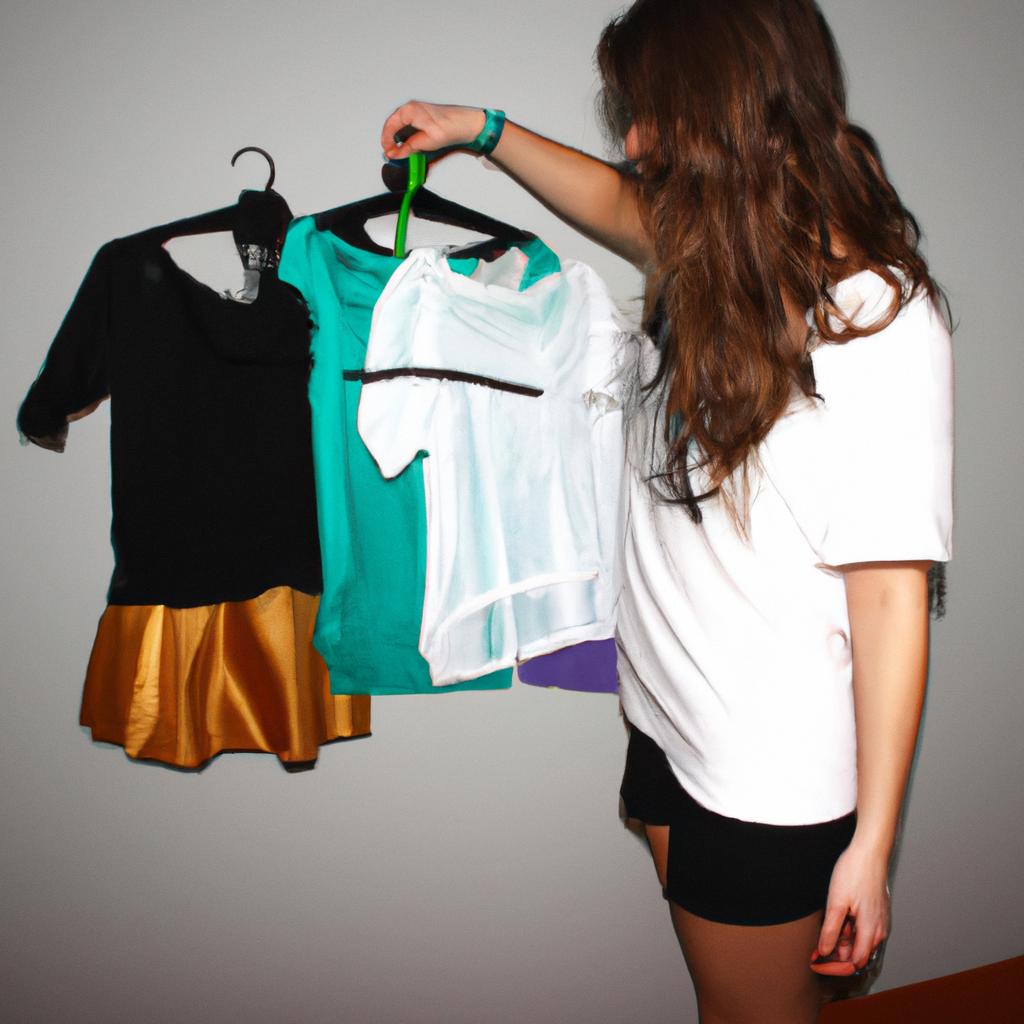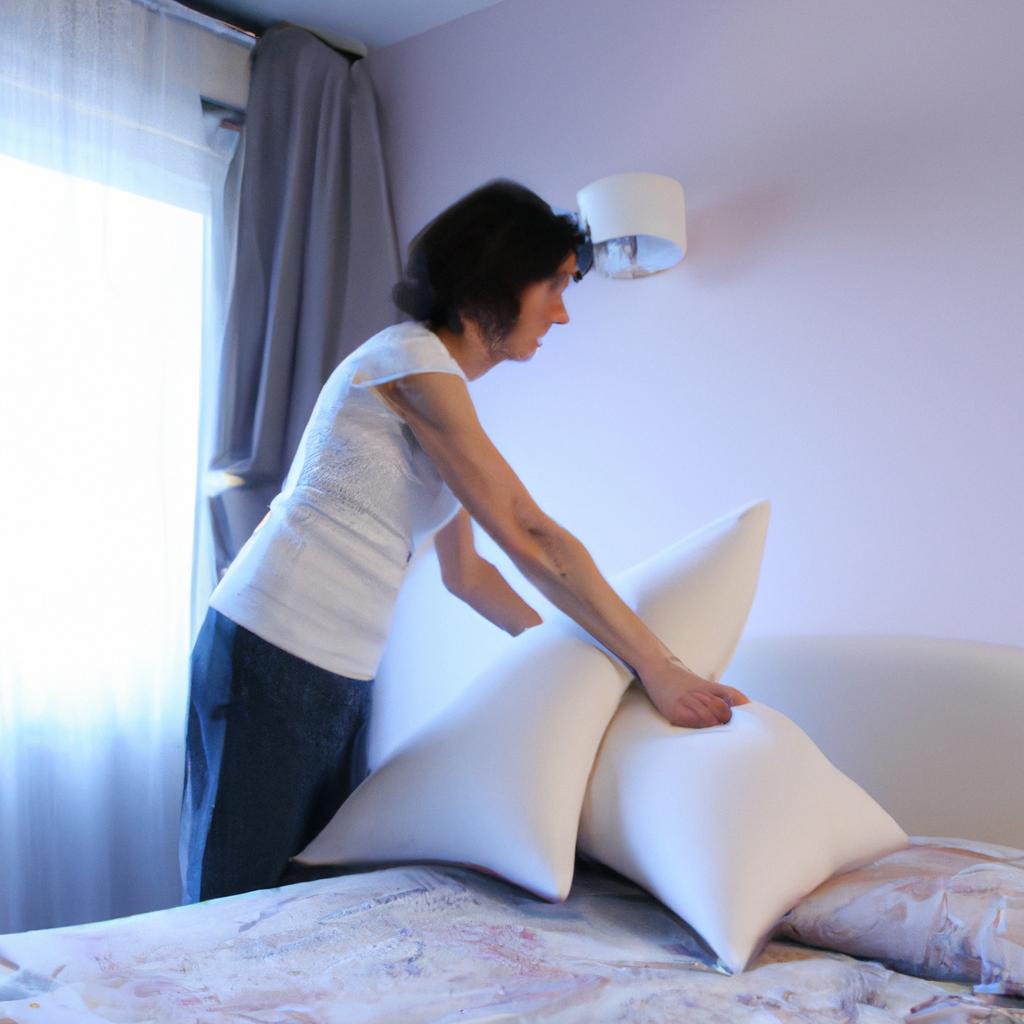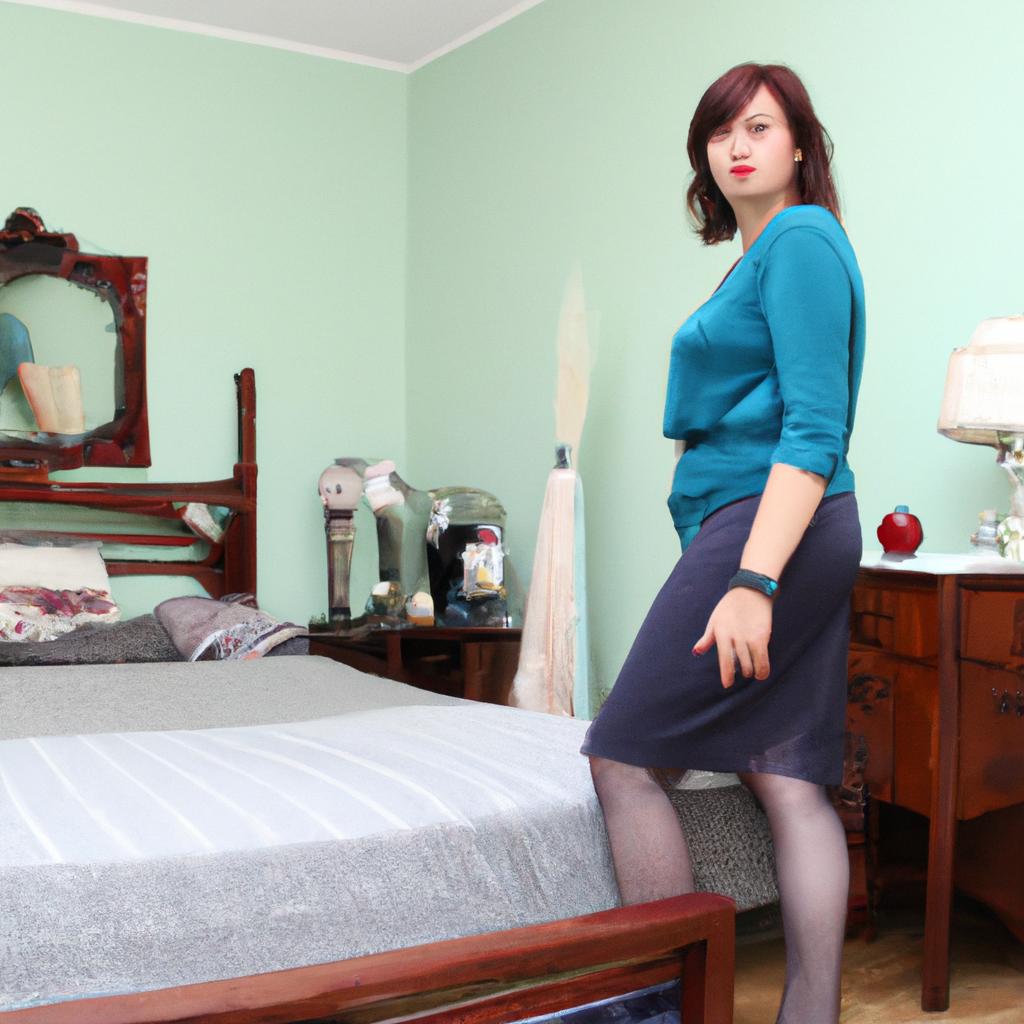Boudoir photography, a genre that celebrates the beauty and sensuality of individuals in intimate settings, requires careful attention to lighting setup in order to create a comfortable atmosphere. The right lighting can enhance the mood, highlight features, and convey emotions effectively. For instance, consider a hypothetical scenario where a boudoir photographer is working with a client who desires an elegant and romantic ambiance for her photo shoot. In this case, the lighting setup becomes crucial in capturing the desired aesthetic and ensuring the subject feels at ease throughout the session.
In order to achieve a well-executed lighting setup for boudoir photography, photographers must understand various factors such as light direction, intensity, color temperature, and shadow play. These elements play a vital role in setting the tone and creating an inviting environment for both the subject being photographed and potential viewers of the final images. By carefully manipulating these aspects of lighting, photographers can produce visually stunning photographs that evoke feelings of intimacy and confidence.
The purpose of this article is to explore different techniques used by professional boudoir photographers when it comes to creating a comfortable atmosphere through their lighting setups. By examining real-life examples or hypothetical scenarios alike, we will delve into how certain lighting choices contribute to establishing trust between photographer and subject while also enhancing the subject’s natural beauty and sensuality.
One technique often employed in boudoir photography is the use of soft, diffused lighting. Soft light helps to minimize harsh shadows and create a flattering, ethereal glow on the subject’s skin. This can be achieved by using large light sources such as softboxes or umbrellas positioned at a 45-degree angle from the subject. By bouncing or diffusing the light, photographers can achieve a gentle, even illumination that enhances the subject’s features without being overpowering.
Another important consideration is the color temperature of the lighting used. Warm tones, such as those resembling candlelight or golden hour sunlight, can help create a romantic and intimate atmosphere. This can be achieved by using warm-colored gels on artificial lights or shooting during specific times of day when natural lighting is warmer. Alternatively, cool-toned lighting can convey a more modern and edgy aesthetic if desired.
In addition to direction and color temperature, understanding how to control light intensity is crucial in boudoir photography. Balancing the overall brightness of the scene with areas of shadow can add depth and dimension to images while also allowing certain details to be selectively highlighted or obscured. For example, strategically placing a dimmer light source behind or beside the subject can create an alluring silhouette effect.
Furthermore, incorporating props like sheer curtains or lace fabric into the composition can introduce interesting patterns and textures through light manipulation. These elements not only add visual interest but also contribute to a sense of intimacy and playfulness within the frame.
Ultimately, creating a comfortable atmosphere through lighting setups in boudoir photography requires careful consideration of various factors such as direction, intensity, color temperature, shadow play, and incorporation of props. Through deliberate choices based on client preferences and desired aesthetics, photographers can capture stunning images that celebrate individual beauty while fostering trust and confidence between themselves and their subjects.
Importance of Lighting in Boudoir Photography
Importance of Lighting in Boudoir Photography
In the world of boudoir photography, creating a comfortable and inviting atmosphere is essential to capturing intimate and stunning images. While various factors contribute to this ambiance, lighting plays a crucial role. By understanding the importance of lighting techniques and how they can enhance the mood of a boudoir photoshoot, photographers can create an environment that allows their subjects to feel empowered and confident.
To illustrate the significance of lighting in boudoir photography, let’s consider a hypothetical scenario. Imagine a client who wishes to have a boudoir photoshoot as a gift for her partner on their anniversary. The photographer must ensure that the lighting setup complements the client’s vision while emphasizing her natural beauty. Failing to do so may result in unflattering shadows or harsh highlights, which could diminish the overall impact of the photographs.
One way photographers achieve optimal lighting is by considering key elements such as warmth, softness, intensity, and directionality. These aspects work together to establish an atmosphere that evokes emotion and creates visual interest:
- Warmth: Utilizing warm light sources like tungsten bulbs or gels can produce a cozy and sensual feeling.
- Softness: Diffusing light through modifiers such as umbrellas or softboxes helps minimize harsh shadows and produces gentle transitions between light and shadow areas.
- Intensity: Adjusting the brightness levels allows photographers to control the mood – from softly lit scenes with subtle contrasts to more dramatic compositions with pronounced highlights and shadows.
- Directionality: Varying angles from which light hits the subject adds depth and dimensionality, accentuating curves and contours.
The table below summarizes these key elements along with their effects on establishing different moods within boudoir photography:
| Key Element | Effect |
|---|---|
| Warmth | Creates intimacy and comfort |
| Softness | Enhances skin tones and reduces imperfections |
| Intensity | Sets the overall mood and drama |
| Directionality | Adds depth and emphasizes curves |
By understanding these elements, photographers can develop a lighting setup that aligns with their clients’ desires and creates an environment where individuals feel at ease. In the subsequent section on “Choosing the Right Lighting Equipment,” we will explore how to select suitable tools for achieving desired lighting effects in boudoir photography sessions.
Choosing the Right Lighting Equipment
Creating a comfortable atmosphere in boudoir photography requires careful attention to lighting setup. By using the right lighting equipment, photographers can enhance mood and create a flattering ambiance for their subjects. In this section, we will discuss some key considerations when setting up the lighting for boudoir photography.
Imagine a scenario where a photographer is shooting an intimate boudoir session with a client who wants to capture her sensual side. The photographer’s goal is to create soft, diffused light that accentuates her features while maintaining a cozy and inviting feel. To achieve this, there are several important factors to consider:
-
Light temperature: Choosing the appropriate color temperature sets the tone for the photo shoot. Warmer tones, such as those produced by incandescent or tungsten lights, can convey a sense of intimacy and romance. On the other hand, cooler tones like daylight-balanced LED lights may evoke a more modern or edgy vibe.
-
Lighting angles: Experimenting with different lighting angles can dramatically alter the mood of the image. For instance, placing the main light source slightly above and to one side of the subject can create flattering shadows while adding depth and dimension to their body contours. Similarly, incorporating fill lights from different directions can help balance out any harsh shadows and ensure an even illumination.
-
Light modifiers: Implementing light modifiers like softboxes or umbrellas helps diffuse light and soften its quality, resulting in smoother skin tones and reduced glare. These tools also enable photographers to control the spread of light, ensuring it falls precisely where desired.
-
Accent lighting: Adding accent lights strategically highlights specific areas of interest within an image—for example, illuminating certain body parts or emphasizing particular props or accessories used during the shoot—enhancing overall visual appeal.
To better understand these concepts visually, let’s take a look at a table outlining various lighting techniques commonly employed in boudoir photography:
| Technique | Description | Emotional Impact |
|---|---|---|
| Rembrandt lighting | Creates a triangular patch of light on one cheek, often used to convey an alluring and mysterious mood. | Evoke intrigue |
| Butterfly lighting | Produces a small, butterfly-shaped shadow under the subject’s nose, typically associated with elegance and grace. | Convey sophistication |
| Rim lighting | Illuminates the edges or outline of the subject, creating separation from the background and adding depth. | Enhance sensuality |
| Silhouette lighting | Backlighting that casts the subject in shadow while highlighting their outline, evoking a sense of mystery and allure. | Create drama |
By carefully considering these techniques and using appropriate equipment, photographers can craft unique visuals that evoke specific emotions within their boudoir photography sessions.
Transitioning into our next section about understanding different lighting techniques for boudoir photography, let us explore how mastering various methods allows photographers to create diverse atmospheres suited to individual client preferences.
Understanding Different Lighting Techniques
Creating a comfortable atmosphere in boudoir photography is essential for capturing intimate and sensual moments. After choosing the right lighting equipment, it’s important to understand different lighting techniques that can be used to enhance the overall ambiance of the photoshoot. By mastering these techniques, photographers can create stunning images that evoke emotions and make clients feel at ease.
One example where lighting techniques play a crucial role is when photographing a client in a bedroom setting. Let’s imagine a scenario where soft and warm light is desired to convey a cozy and romantic mood. In this case, using specific lighting setups such as butterfly or Rembrandt lighting can help achieve the desired effect. These techniques involve positioning the main light source in a way that creates gentle shadows on the subject’s face while providing an even illumination throughout the scene.
To further emphasize the importance of creating a comfortable atmosphere through lighting, consider the following bullet points:
- Soft and flattering light helps build trust between photographer and client.
- Proper lighting enhances body positivity by highlighting curves and minimizing imperfections.
- The choice of color temperature influences the emotional tone of the image.
- Using directional light can add depth and dimension to portraits, making them more visually appealing.
In addition to understanding different lighting techniques, utilizing various modifiers can significantly impact the final result. A three-column, four-row table showcasing popular modifiers could include options like diffusers, reflectors, umbrellas, and beauty dishes. Each modifier has its unique characteristics that influence how light interacts with the subject, allowing photographers to tailor their approach based on individual preferences or creative goals.
Transitioning into our next section about creating soft and flattering light, one technique worth exploring is backlighting. This method involves placing your primary light source behind your subject to create a halo effect around their silhouette. Through proper positioning and adjustment of exposure settings, backlighting can produce dreamy results that exude sensuality without revealing too much detail. With this knowledge in mind, let’s dive into the specifics of how to achieve this captivating lighting effect.
Creating Soft and Flattering Light
Building upon our understanding of different lighting techniques, let us now explore how to create soft and flattering light in boudoir photography. By employing these techniques, photographers can enhance the overall ambiance, creating a comfortable atmosphere for their subjects.
Example: Imagine capturing an intimate moment between a couple in a dimly lit bedroom. To convey the warmth and intimacy of the scene, it is essential to use soft and flattering light that enhances their features while maintaining a sense of romance and sensuality.
To achieve this desired effect, consider implementing the following strategies:
- Utilize diffused lighting sources such as softboxes or umbrellas to soften harsh shadows.
- Experiment with various types of light modifiers like gels or silks to add subtle color tones or diffusion.
- Position your lights strategically to sculpt facial features, accentuate curves, and minimize unflattering angles.
- Adjust the intensity of your light sources according to the mood you wish to convey; softer lighting tends to evoke feelings of comfort and tenderness.
By incorporating these techniques into your lighting setup, you can create a captivating environment that flatters your subjects and evokes genuine emotions. Let’s take a closer look at how these principles come together by examining Table 1 below:
Table 1: Elements Contributing to Soft and Flattering Light
| Lighting Technique | Effect on Subject |
|---|---|
| Diffused Lighting | Smooths skin texture |
| Color Gels | Adds warmth or coolness |
| Silks | Creates gentle diffusion |
| Strategic Placement | Highlights desired features |
As depicted in Table 1 above, each element contributes to achieving soft and flattering light in boudoir photography. However, keep in mind that experimentation plays a crucial role in finding what works best for each unique scenario.
With an understanding of these techniques under our belt, we are now ready to dive into the next section on accentuating mood with creative lighting. By incorporating innovative approaches, we can further enhance the atmosphere and emotions captured in boudoir photography sessions.
Accentuating Mood with Creative Lighting
In the previous section, we explored how to create soft and flattering light in boudoir photography. Now, let’s delve into another crucial aspect of lighting setup—accentuating mood with creative lighting techniques.
To better understand the impact of creative lighting on creating a comfortable atmosphere, consider the following scenario: Imagine a boudoir photo shoot where the goal is to capture an intimate and sensual ambiance. By strategically using colored gels on the lights, it becomes possible to infuse warm tones that evoke passion and desire. This technique adds depth and complexity to the overall composition, enhancing the emotional connection between the subject and viewer.
When aiming for a specific mood or atmosphere in boudoir photography, employing various innovative lighting methods can have a profound effect. Here are some key approaches photographers often use:
- Silhouetting: Placing a strong backlight behind the subject creates intriguing silhouettes that emphasize curves and contours.
- Patterned shadows: Using patterned gobos or curtains to cast artistic shadow patterns on walls or subjects adds visual interest and drama.
- Window light: Harnessing natural window light produces soft illumination while also providing a sense of intimacy by simulating morning sunlight filtering through curtains.
- Candlelight effects: Incorporating flickering LED candles or small practical lights can simulate romantic candlelit settings, adding warmth and elegance.
Table 1 below summarizes these different lighting techniques along with their intended emotional impact:
| Lighting Technique | Emotional Impact |
|---|---|
| Silhouetting | Sensual |
| Patterned Shadows | Dramatic |
| Window Light | Intimate |
| Candlelight Effects | Romantic |
By skillfully implementing these creative lighting techniques, photographers can elevate their boudoir images to convey specific emotions effectively. The interplay between light, shadow, colors, and textures within each shot contributes significantly to establishing a comfortable atmosphere conducive to capturing the desired mood.
Moving forward, we will explore tips for achieving a comfortable ambiance in boudoir photography by considering factors beyond lighting alone. By integrating these insights into your workflow, you can further enhance the overall experience and results of your boudoir shoots.
Tips for Achieving a Comfortable Ambiance
Creating a Comfortable Ambiance in Boudoir Photography
Accentuating mood with creative lighting is just one element of creating a comfortable atmosphere in boudoir photography. The way the space feels and the overall ambiance can greatly impact both the photographer and the subject, leading to more expressive and natural photographs. By considering various factors such as color temperature, light positioning, and props, photographers can enhance their clients’ comfort levels and ensure a positive experience.
For instance, imagine a scenario where a client arrives at a dimly lit studio for their boudoir photoshoot. As they step into the room, soft warm-colored lights illuminate the area, casting gentle shadows on strategically placed accessories like plush pillows or delicate curtains. This intentional arrangement immediately sets a relaxing tone and helps alleviate any initial nervousness or self-consciousness that the client may feel.
To create an inviting atmosphere in boudoir photography sessions, consider the following techniques:
- Utilize warm-colored bulbs: Opt for light sources with warmer color temperatures (around 2700K) instead of harsher white or blue tones. Warm lighting evokes feelings of coziness and intimacy.
- Incorporate accent lighting: Use additional lights to highlight specific areas or objects within the scene. For example, placing a small spotlight on a decorative mirror could add depth to the composition while drawing attention away from potential insecurities.
- Experiment with diffused lighting: Softening your light source through diffusion materials such as umbrellas or softboxes can help create flattering skin tones and reduce unflattering shadows.
- Employ scented candles or aromatherapy oils: Introducing pleasant scents not only enhances relaxation but also contributes to an overall sensory experience that connects back to personal memories associated with smell.
By implementing these strategies, photographers can establish an environment conducive to capturing authentic moments during boudoir photography sessions.
| Techniques for Creating Comfortable Atmosphere |
|---|
| Utilize warm-colored bulbs |
| Incorporate accent lighting |
| Experiment with diffused lighting |
| Employ scented candles or aromatherapy oils |
In summary, when it comes to boudoir photography, achieving a comfortable ambiance is crucial for capturing intimate and natural images. By carefully considering the elements that contribute to a welcoming atmosphere—such as warm-colored lighting, accent lights, diffusion techniques, and pleasant scents—photographers can create an environment where clients feel at ease and confident in front of the camera. This attention to detail ultimately enhances the overall experience and results in stunning photographs that truly reflect the beauty and personality of each individual.
 LW Larsen Photo
LW Larsen Photo


